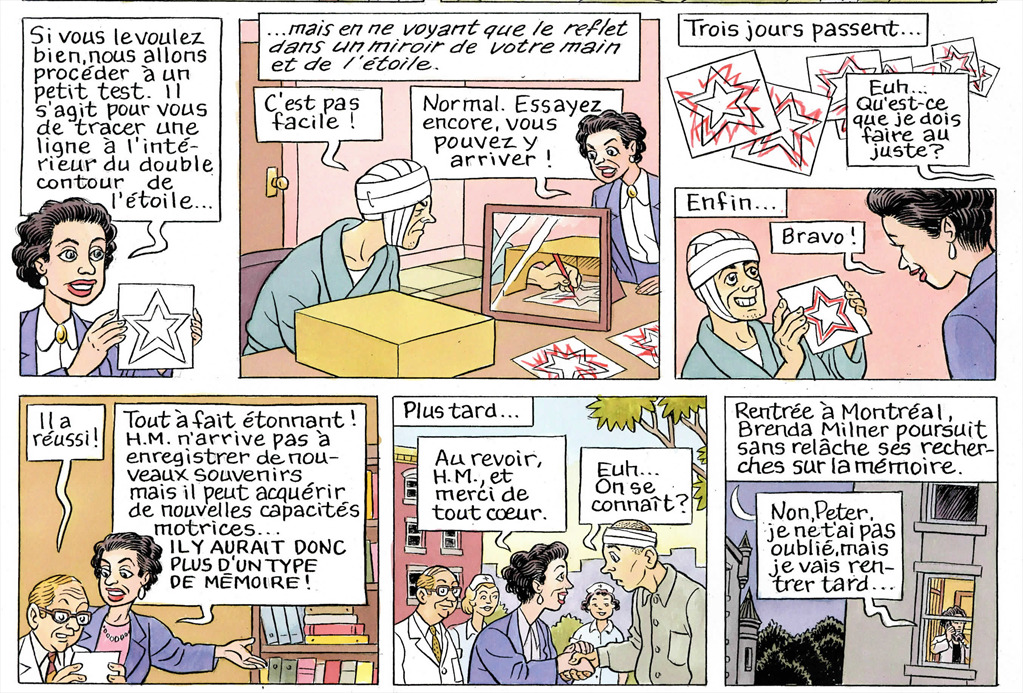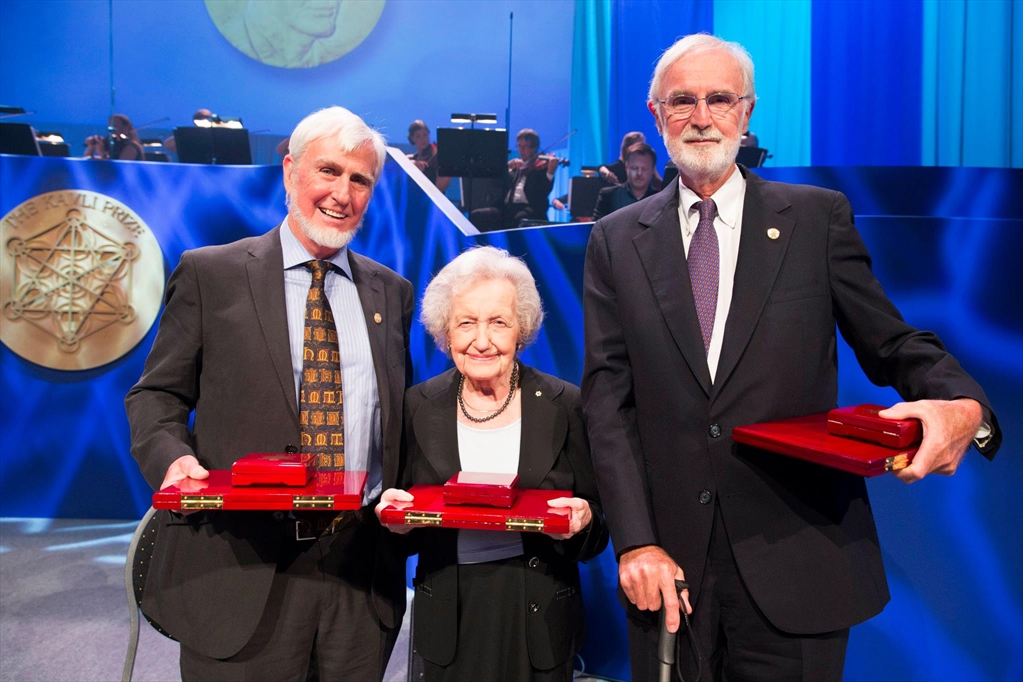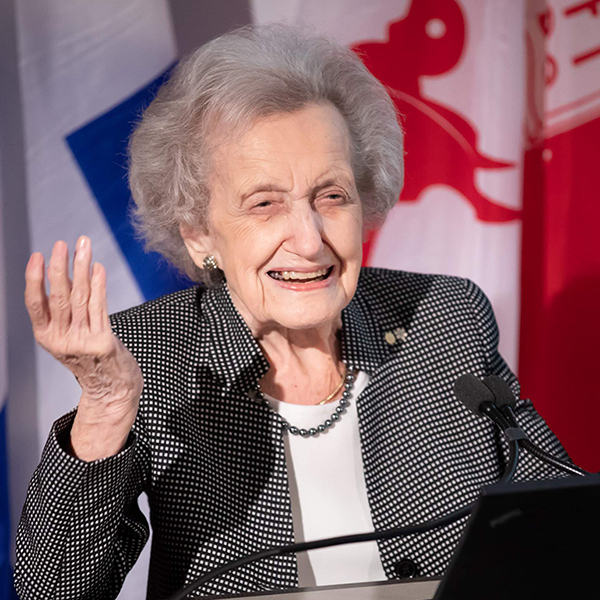A simple drawing exercise led Brenda Milner, PhD’52, DSc’91, to a discovery that would radically rearrange everything we thought knew about memory.
Milner, who celebrated her 100th birthday on July 15, and continues to do research at the Montreal Neurological Institute and Hospital, still likes to describe how the discovery unfolded. In 1957, a surgeon colleague asked her to examine Henry Molaison, a 29-year-old man from Connecticut who had suffered bilateral brain lesion in surgery that left him amnesiac.
“From one day to the next, ‘HM’ couldn’t remember a thing,” says Milner, the Neuro’s Dorothy J. Killam Professor. “But I asked him to trace a five-point star while watching his hand in a mirror. The mirror changes everything. He had to learn to draw again from scratch. Not only did he learn, but he remembered what he learned the next day.”
His ability to progress in this new skill from one day to the next was a startling finding. The case of “HM” – his real name was only revealed when he died in 2008 – proved that conscious memory, and memory of motor activities, are separate and distinct capacities.

“[She] demonstrated that there wasn’t just one type of memory, but a multitude of types. It was revolutionary,” says cognitive neuroscientist Julien Doyon, PhD’88, director of the Neuro’s McConnell Brain Imaging Centre.
“Brenda Milner is one of the most important contributors to the study of human memory storage,” says Columbia University neuroscientist Eric Kandel, a Nobel Prize winner for his research on the physiological basis of memory storage in neurons.
Kandel explains that Milner’s studies were among the first to demonstrate that brains could reorganize their functions after damage from an accident or surgical operation. “She was one of the people who pointed out that the hippocampus [the small organ in the brain’s medial temporal lobe, resembling a seahorse, that is associated with long-term memory] was important for memory storage. Her demonstration that the hippocampus was critically involved in memory storage was a revolution for the field.”
“Researchers to this day are still working on her observations,” says Doyon, who investigates the changes in neural networks associated with the acquisition of motor skills. “I am one of thousands of researchers in the world studying different types of memory, who are essentially working on the same questions she was asking 65 years ago.”
Over the decades Milner has guided dozens of young researchers toward careers in neuropsychology and neuroscience. “Her students have built on her original observations,” says Denise Klein, one of Milner’s former protegés and now the director of McGill’s Centre for Research on Brain, Language and Music. Klein and Milner have collaborated for the last 26 years, studying bilingual subjects to understand how different neural pathways are used to acquire new and native languages.
Doyon says Brenda Milner is known by her students as the “Manchester Filter” – Manchester is the British city where she was born and “filter” because she doesn’t let mistakes slip by her. “As a mentor, she is very, very demanding,” says Doyon, who did his doctoral thesis under her supervision. “She returned my writing to me with entire pages covered in red lines. It meant, “Go back to the drawing board,” or “nothing salvageable.”
“You know exactly where you stand with her and what her position is on things,” says Klein. “But she is quite open to letting people explore what they find interesting. And she provides a supportive role for that.”
Klein believes Milner’s work has stood the test of time because she built her research on firm results. “She has always been very data driven. She never had specific ideas she wanted to prove. She always worked with what the results showed.”
Born in in 1918, Milner (then Brenda Langford) won a scholarship to the University of Cambridge, where she earned a degree in experimental psychology in 1939. That’s where she met her future husband Peter Milner. When he was asked to help launch Canada’s atomic energy research program in 1944, the couple got married and moved to Montreal. “I thought I’d stay in Montreal for one year and here I am!” says Milner, who taught psychology at the Université de Montréal before moving to McGill in 1953.

Though a pioneer among women working in science, Milner has little interest in dwelling on the subject. “Opportunities for women in my time were very limited by the fact that few universities admitted women in the 1930s,” she says. “But I was very ambitious. My mother was very ambitious for me. I like competition. We are born like that, or not.”
Asked about her longevity, Milner responds, “I think it’s genetic. My mother, who was a musician, lived to be 95 and was teaching music until she was in her eighties. I think part of my longevity just comes from stubbornness. It has nothing to do with talent. Some people get put off by the first little difficulty. I’m just not easily deterred.”
At 100 years of age, Milner still walks to her office a few days a week. “She still has a postdoc student working on inter-hemispheric differences in the brain,” says Doyon. “I’m not the slightest bit surprised she has never retired. I don’t think the word is in her vocabulary.” Adds Klein, “I don’t think she differentiates between work and play.”
Milner admits she’s dazzled by the progress science has made during her 70-year career. “Until neuroimaging became possible, in the 1980s, we had to wait until people died to really see their brains. I still remember seeing neuroimaging for the first time. Oh my God! The living brain in action! It was marvellous.”
